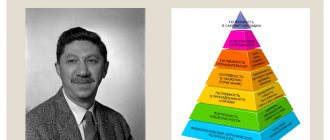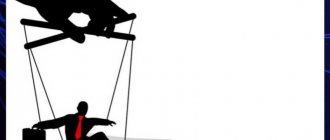A person who violates generally accepted rules (morals, behavior in society, regulations in various institutions and even laws) is perceived by society as a problematic person. Most believe that this is dictated by a lack of upbringing or pathologies of mental development. However, this attitude is most often erroneous, because the essence of “rebellion” lies in inability to adapt to certain conditions of existence. In psychology there is a name for this phenomenon - maladjustment. It requires lengthy and complex correction, which is impossible without a specialist.
What it is
Disadaptation is a person’s inability to adapt to certain, most often new, conditions of existence. It finds expression in behavior that is not typical for him in his usual environment. For example, at home he can behave completely normally: communicate with family and neighbors, take care of his parents, keep the apartment clean, and show respect for family values. At work, he changes radically: he cannot establish contact with colleagues and superiors, he is rude or withdrawn and does not utter a word, does not comply with the company’s Charter (he is late, smokes in the wrong place).
Maladaptive behavior is a violation of the basic rules of society that apply in certain conditions (at work, at school, in the family, in a government agency, in any association).
However, with maladaptation, not only behavior changes, but also the psychophysical state of a person. If at home he is calm and feels great, then at work his level of anxiety rises sharply, his breathing and heart rate quicken, he sweats profusely, and panic attacks occur. This condition affects almost all personal spheres - emotional, physiological, behavioral.
How this could end:
- with successful correction and outside help, adaptation will go well and the person will be able to learn the rules and regulations,
- in their absence, he will not withstand the emotional load, aggravated by physiology, and will fall out (consciously or not) from these living conditions: change jobs, get divorced, stop going to school,
- will continue to tolerate them, and this maladjustment will force him to live in constant stress.
The last case is the most difficult. Psychologists say that more than 30% of people can be called maladjusted, since they cannot emotionally, physically and psychologically accept the work conditions they have to go to every day. They don’t turn to specialists for help, and they don’t try to look for a new place for various reasons (here it’s closer to home, they pay well, but what if it turns out worse there).
On a note. In medicine there is a similar diagnosis: maladjustment syndrome. It is given to newborns with cardiovascular disorders due to perinatal hypoxia.
Danger of violation
At first glance, it may seem that maladaptation does not pose a serious threat and, if desired, the child can be forced to adequately respond to some situations and problems.
However, this is not quite true. When parents and teachers do not see a child’s maladjustment as a serious problem and do not try to correct his behavior, then such inflexible behavior is reinforced at the psychophysical level.
As a result, the child becomes firmly entrenched in certain psychological habits that are difficult to correct, even if worked through with a psychologist. Often, parents and teachers do not see the problem with maladjustment in the child and attribute behavioral characteristics to character.
On the other hand, calculating maladaptation at some initial phase is not easy, since it does not appear immediately, therefore another danger of this condition lies in the difficulty of recognizing this behavioral deviation. Most often, it becomes obvious that a person is completely maladjusted only when he finds himself in a difficult situation and turns out to be completely unadapted to it.
Causes
Disadaptation is facilitated by various factors, which can work both individually and in combination. They are divided into exogenous and endogenous.
Personal (internal) reasons lead a person to insufficient fulfillment of his needs in society. It can be:
- long-term illness
- mental illnesses and disabilities,
- limited opportunities,
- long-term isolation,
- switching to another field of activity (long business trip, academic leave, maternity leave),
- pedagogical neglect, lack of education.
Environmental (external) factors create unusual, uncomfortable conditions of existence for a person, which can restrain his personal manifestations. These include:
- unfavorable family environment,
- lack of love and attention to the child from the parents,
- lack of mutual understanding with peers, rejection by the team,
- a new environment, a change in the usual way of life, unexpected events, crisis (turning) moments,
- “market education”: lack of material wealth makes a person a black sheep,
- the negative influence of the Internet and the media, which form the concept of an idealized virtual world that has nothing in common with the real one,
- the maladaptive influence of one person (teacher, parent, boss, husband),
- physical and emotional overload (especially acutely felt by a child when entering first grade).
When correcting the behavior of a maladjusted person, it is necessary to take into account the factors that provoked this condition. If a number of reasons can no longer be eliminated (lack of parental love in childhood or pedagogical neglect), then some of them can be eliminated (the influence of an authoritarian personality or the Internet).
Signs
In children, maladaptive behavior is noticeable to the naked eye, even to a non-specialist. Parents, teachers, school psychologists, and peers see this. In adults it may be more veiled. For example, if a person does not want to lose his job and does not have mental disabilities, he can hide his dissatisfaction, although this can still be seen by some external manifestations (disrespect for colleagues and boss, systematic tardiness, frequent sick leave, depression). Psychologists call the most striking signs of maladjustment:
- irritability, which extends not only to others, but also to one’s own behavior,
- aggression,
- negative thinking (bad thoughts prevail over good ones),
- withdrawal into oneself: lack of new acquaintances, breakup of old relationships, loss of connections with friends and family, replacement of the real world with an illusory one,
- concentration on oneself, complete immersion in one’s own experiences, emptiness,
- partial or complete violation of moral and legal norms, rules in force in the conditions in which he found himself,
- an attempt to adapt the environment to oneself, but not oneself to new conditions,
- maladjusted children (especially teenagers) are characterized by pronounced antisocial, deviant behavior,
- deterioration of mental state: depression, nervousness, inadequate assessment of oneself and what is happening, panic attacks, anxiety,
- deterioration of physical health: pressure surges, increased heart rate, increased sweating and other vegetative-vascular symptom complexes.
The most critical manifestation of maladjustment, according to psychologists, is social phobia, which, if uncorrected, can lead to suicide and, in childhood, autism.
Condition correction
As mentioned earlier, the state of maladjustment is not permanent and can be overcome. To do this, it is necessary to work through internal fears and anxieties. Both children and adults with this problem can and should contact psychologists.
An effective method in combating the fear of communication is to overcome yourself and force yourself to communicate. This will help you cope with your fear of people. You should also develop optimistic, positive thinking, which will facilitate the establishment of new connections and contacts.
Children and adolescents, due to their age, are not able to overcome this condition on their own, therefore they need the support and help of their parents, who, if necessary, can always get specific advice from a psychologist.
The concept of “maladaptation” in psychology means the inability of an individual to adequately and painlessly contact the outside world.
Nowadays, the problem of maladjustment in children and adolescents sometimes arises very acutely, which is associated not only with difficulties in building communication that arose earlier, but also with the negative side of the development of progress, when children from an early age have the opportunity to immerse themselves in virtual reality.
This contributes to even greater detachment and consolidation of antisocial behavior, when a child who has not received timely psychological help in adulthood turns out to be unable to solve emerging problems and prefers an isolated lifestyle.
Levels
In psychology, there are several levels of maladjustment.
- Null
These are prerequisites for the fact that maladaptation is embedded in the human psyche from childhood, and it can manifest itself at any moment of conflict or crisis period. At this stage there are no personal deviations or deformations of moral values. However, the tendency can be recognized by a special line of behavior (frequent riots, denial, rudeness, bad manners). Easily amenable to correction through mastering social norms.
- Formation of attitudes
If at the zero stage the tendency towards maladaptation was not noticed, and therefore did not undergo correction, negative social attitudes begin to form. Personal deformations are still not observed, but the person begins to depend on the behavior of others, although outwardly he tries to demonstrate that he does not care. At this stage, maladaptive protest can be expressed in smoking, drinking alcohol, or joining informal groups. Correction methods include training and individual work with a psychologist.
Types of groups of minors behind the theory of Pirozhkov V.F.
V.F. Pirozhkov, studying the mechanisms of formation of attitudes toward joint antisocial and criminal activities, identifies six types of youth groups:
- Members of the first type are united by a single criminal attitude based on conscious association and rallying around “leaders”, “authorities” who have previously served sentences;
- The second type is characterized by the expression of group criminal attitudes among some members and accession through the mechanism of mental infection and imitation among others;
- The third type are communities that include individuals with criminal and antisocial attitudes and minors with positive values, but who have been “pushed out” of the positive role space due to dysfunction in the family or school;
- The fourth type is communities with unformed antisocial attitudes, when antisocial motivation often arises in the process of joint communication, in a situation of provocative actions of others;
- The fifth type of association is that young people experience an inferiority complex, social inferiority, which provokes antisocial forms of self-affirmation through the mechanism of false compensation;
- The sixth type of group consists of adolescents with positive attitudes and orientations - antisocial behavior is expressed in chance, incorrect assessment of the situation and expected consequences [33]. From the point of view of studying the mechanisms of formation of social maladjustment, it is necessary to pay attention to the study of the motivational structure of juvenile delinquents T.Sh. Anguladze, who identifies the following groups of antisocial offenders:
- Offenders in whom antisocial behavior is not accepted and assessed negatively;
- Offenders who have a positive emotional attitude towards crime, but evaluate it negatively;
- Offenders who have a positive emotional attitude towards crime coincides with a positive assessment of it.
The obtained psychological characteristics of juvenile delinquents, which were described by Feldstein D. I, allowed the researcher to conditionally identify five groups of juveniles based on a certain type of behavior, taking into account the degree of antisocial orientation of the individual:
1) adolescents with a stable complex of socially negative, abnormal, immoral, primitive needs, with a system of openly antisocial views, deformation of attitudes and assessments;
2) adolescents with deformed needs, low aspirations, striving to imitate the first group of juvenile delinquents;
3) adolescents, who are characterized by a conflict between deformed and positive needs, attitudes, interests, and views;
4) adolescents with slightly deformed needs;
5) teenagers who accidentally took the path of delinquency.
However, such a characteristic of representatives of the last group as “involuntary and susceptible to microenvironmental influences” suggests that they are not random. This does not indicate the randomness of offenders, but one of the typical factors of antisocial phenomena (in the form of such an accentuation of character, according to A.E. Lichko, as conformity).
Types of maladjustment and their characteristics
It is not possible to describe absolutely all types and types of maladjustment, since this is too multifaceted a phenomenon. Therefore, in psychology there are several classifications.
Generally accepted classification
It is based on those factors that provoke the development of maladaptation, and those areas of the personality that it deforms.
Social
The essence: loss of connections and contacts with society.
Leading sign: antisocial behavior.
A striking example: joining a new team due to a change of job, school, place of residence and rejection of its rules.
Methods of correction: group trainings, social adaptation, work on interpersonal relationships.
Pathogenic/mental maladjustment
Essence: nervous, mental illnesses and deviations.
Leading symptom: inadequate reaction to what is happening, inability to control one’s own behavior and emotions.
Vivid examples: phobias, alcohol or drug addiction, obsessive-compulsive disorder, neurasthenia, bipolar personality disorder.
Methods of correction: psychotherapy, psychiatry, treatment of the leading disease that became the cause.
Psychosocial/psychological maladjustment
The bottom line: non-perception of social norms is associated with personality deformations.
Leading sign: inability to establish contact with others due to internal complexes and incorrectly formed self-esteem.
A striking example: a child spoiled by his parents, who did not attend kindergarten, went to first grade, and it is difficult for him to realize and accept the fact that there are at least 20 other children nearby who also require the attention of adults.
Methods of correction: group and auto-training, work with a psychologist.
It is extremely difficult to grasp the fine line between social and psychosocial types of maladaptive behavior.
Other classifications
Depending on the involvement in the process:
- partial - temporary loss from public life (due to illness, business trip),
- complete - antisocial behavior is accompanied by profound personal changes.
Depending on the conditions:
- School
It is observed when a child cannot fit into the norms and rules of school life. Most often it is diagnosed during the transition from kindergarten to 1st grade, from primary to secondary school, and at an older age it is associated with adolescence and puberty. This is almost always a psychosocial partial maladaptation, which can be overcome with the help of parents, teachers and psychologists. Less often, it acquires the features of a pathogenic form and becomes a stable neoplasm in the psyche.
Read more in the article: School maladjustment
- Professional
The reason may be not only a change in activity or place of work, but also conflicts with superiors or colleagues. It can manifest itself in completely different ways: someone openly speaks at all meetings with accusatory speeches, tries to adjust the rules and conditions to their comfortable existence, someone tolerates and accumulates discontent in themselves.
The role of mental adaptation in the development of a healthy personality
The understanding of psychological adaptation as an adaptive process aimed at protecting the body and psyche from the destructive effects of environmental factors is found in many authors. For example, a typical statement is: “When we began to study the phenomenon of psychological environmental maladaptation, we proceeded from the well-known assumption that in the multidimensional space of various factors that determine the interaction of personality and environment, only an abstract person can be fully adapted, while real people are forced to make constant efforts to overcome various kinds of difficulties that threaten their stable condition” [3]. From the position of the existential approach, no one can force a person to waste energy, and a “stable state” for him means the cessation of mental growth and personal development.
Mental adaptation should be understood as processes and phenomena that occur at the level of mental activity and are the result of an active solution to problematic mental situations. A problematic mental situation is the central concept of the concept of mental adaptation. A problematic mental situation is understood as the presence of a real need in an individual to resolve a global conflict, with the fundamental intractability of this conflict by the usual means and mechanisms of mental regulation and, associated with this, an extremely high degree of mental stress. In fact, this definition was formulated by M. Argyle.
In modern psychology there are many related concepts. In particular, when analyzing the psychology of interpersonal conflict, N.V. Grishina uses the term “critical life situations,” including stress, conflict, crisis [15]. The modern understanding of psychological adaptation coincides with the author’s definition of constructive overcoming of personal conflicts and crises: “Effective strategies are aimed at “working” with the problem itself, with the content of the created contradiction and have the goal of overcoming the obstacles that this problem creates in the way of the possibility of self-realization of the individual, his self-realization and a fulfilling life. In other words, we can evaluate a person’s recovery from a conflict or crisis as productive if it truly “frees” him from the problem that caused it in such a way that he becomes more mature, psychologically adequate and integrated.” In other words, we can say that mental adaptation is mental regulation in a problematic mental situation, in a state of stress. Like physiological regulation, described by G. Selye as an adaptation syndrome, mental adaptation has its own patterns, phenomenology and dynamics of its course. The main difference between psychological adaptation and adaptation syndrome, according to G. Selye, is that it is determined by the activities of the individual. Activation of physiological adaptation mechanisms occurs regardless of consciousness, due to the effect of stress factors on the body. Mechanisms of psychological adaptation are activated through their own activation of selective and conscious connections (relationships), which then become the content of the psychological problem. A problematic psychological situation is essentially created by the individual, although the course of the adaptation process superficially resembles the adaptation syndrome.
Diagnostics
Psychologists and psychotherapists can recognize signs of maladaptation by a person’s characteristic behavior and related indicators of his mental and physical health. If in children all this is diagnosed quickly enough, then with adults, especially if they mask their dissatisfaction, sometimes you have to work for a long time. First, a conversation is held with a specialized specialist, and if necessary, a medical examination is prescribed. But psychological tests are becoming the main diagnostic tool.
- Luscher
It is possible to identify a state of maladjustment according to Luscher. His mixed and achromatic color tables determine the degree and style of deviation. For example, yellow in a certain position indicates rejection of one’s profession, and purple indicates a woman’s rebellion against her own pregnancy.
- Leary
Another famous questionnaire, Leary’s, helps determine the degree of maladjustment. Its goal is to identify the difference between “I am real” and “I am ideal.” The deeper it is, the more advanced the form of pathology. The condition is characterized from the point of view of such key personal formations as deceit, acceptance/non-acceptance of oneself/others, emotional comfort/discomfort, internal/external control, dominance, control and escapism.
- Personality factors
Another questionnaire characterizing several personality types, among which there are those who are prone to rejecting social norms and attitudes. For example, the personality type “k+” is characterized by a social form of rejection, “d+” is characterized by maladaptation of the depressive type, and “d-” is characterized by the cyclothymic type. Their descriptions are given in the answers to the test.









